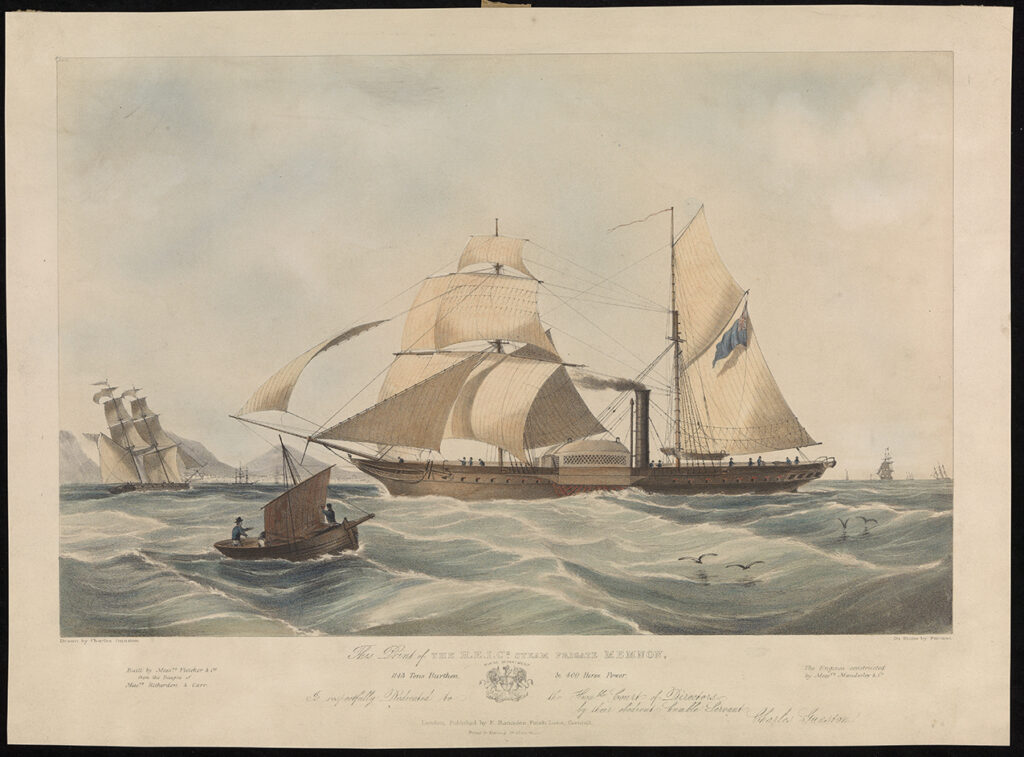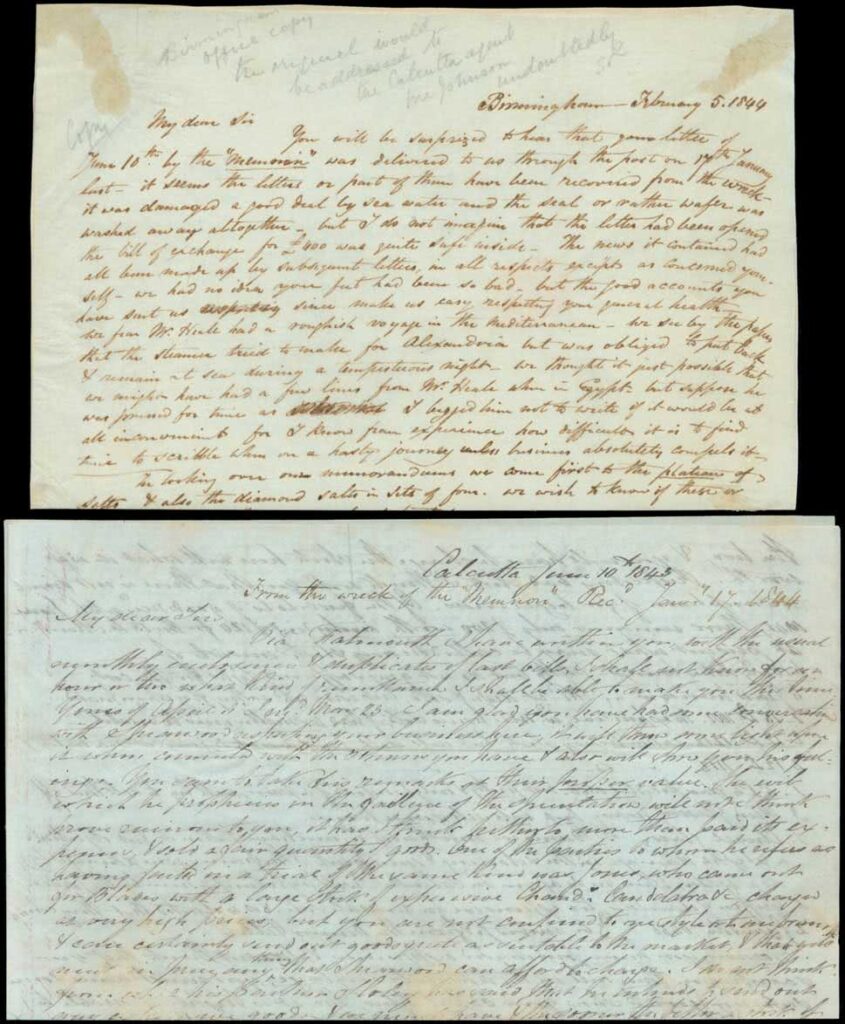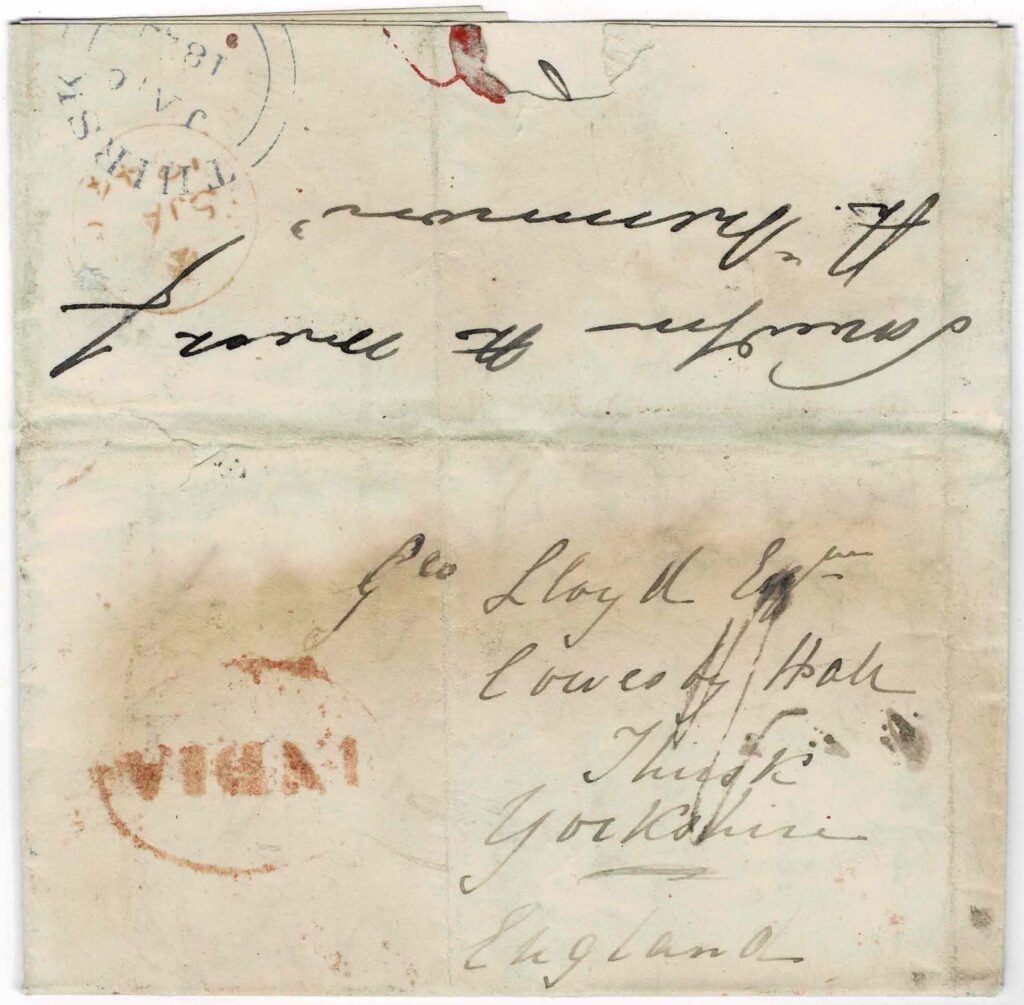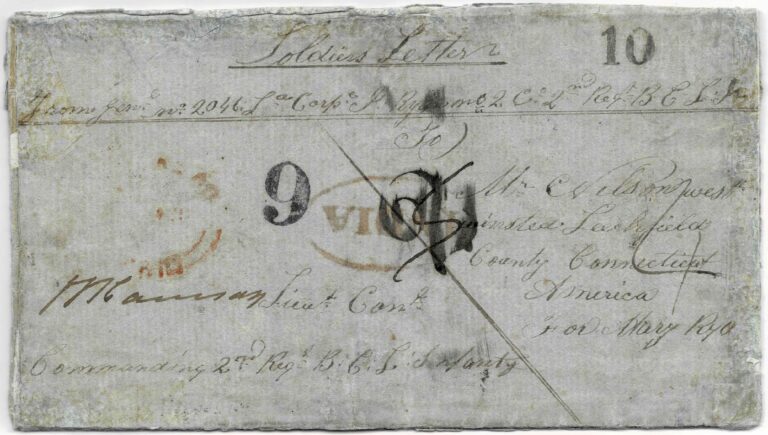Recently, in an auction, I found an entire from the 1840s which was on the East India Company’s (EIC) paddle steamer, Memnon, when it wrecked in August 1843. While much has been written about this wreck, both from a historical and postal history perspective, I can’t resist penning my two-bits! While the main focus will be on the entire, as is usual with my online posts, I will also digress into other philatelic and non-philatelic, but related, matters.
The mythological Memnon
In Greek mythology, Memnon (which, in ancient Greek means ‘resolute) was a king of Ethiopia and son of Tithonus (son of Laomedon, legendary king of Troy) and Eos. As a warrior he was considered to be almost Achilles’ equal in skill. During the Trojan War, he was killed by the latter (Figure 1).

The modern Memnon
Coming to more modern times, EIC Memnon (Figure 2) was a paddle steamer, 1143 tons, built in 1841 by Fletcher, Son & Fearnall, Limehouse. She was considered as the “finest and fastest sea-boat in the Indian seas” being much bigger and more powerful that any other steamer in the Company’s service. She had two 400 hp engines each with twin cylinders and could reportedly do 12 to 14.5 miles per hour under steam and sail.

Memnon sailed from England for China early in 1842 under Commander Frederick Thomas Powell, but arrived there just too late to be actively engaged in the Opium War. In December 1842 she left Hong Kong to take up station at Bombay, where she arrived on 26 January 1843. She made a couple of trips to the mouth of the Indus (Kurrachee) before preparing for her first voyage to Suez with the Overland Mail. At 4.30 PM on 22 July 1843 she sailed from Bombay into the southwest monsoon. She was still not powerful enough to steer the direct course to Aden for long. After two days, she took a more southerly course, but still made remarkably good time and was on course to reach Aden in record time. Facing terrible weather on 31 July and 1 August, she was wrecked at about 11 PM on 1 August off Cape Guardafui, Somalia (Figure 3).

There were 170 on board, of which just seven were passengers. No lives were lost but it was initially believed that the mails were. Commander Powell was arraigned before a court-martial on the 3 April 1844, for the loss of his ship, but was fully acquitted of all blame. Those interested to read more about Memnon’s fight against the elements and her capitulation can see Charles Rathbone Low’s History of the Indian Navy (1613-1863) (chapter 3 of volume II, pg. 160-165).
Census of Memnon wreck letters
Hopkins’ letter
In his famous A History of Wreck Covers (3rd edition), A. E. Hopkins mentions that he has an undated cover bearing the oval Royal Arms handstruck stamp “HONG KONG POST OFFICE”. The cover has a label attached, the latter being illustrated but not the full cover, with the legend in manuscript:
From the wreck of the Memnon
As per the auction description, this cover, which bears a dubious label, has been discredited. However when I inquired with the auction house further, they weren’t able to substantiate this statement!
The cover was auctioned in a Robson Lowe Hong Kong sale of 20 December 1939. However, as might be expected with catalogues of that age, this lot is not photographed. Unless we can find an image of the cover and study it further, it won’t be possible to comment on its veracity.
Raine’s two letters
In an article published in Bulletin 109 of September/October 1960, Sydney Raine announces the the acquisition of “a mass of correspondence from Calcutta to a chandelier manufacturer in Birmingham (1840-1880)”. In it were found two letters of 1843-44.
One was a letter dated 10 June 1843 which was on the wreck; the recipient had written:
“From the wreck of the “Memnon”. Recd. Januy. 17, 1844”
The second was the office copy of a letter datelined ‘Birmingham February 5, 1844’ which says:
You will be suprized to hear that your letter of June 10th by the “Memnon” was delivered to us through the post on 17th January last. It seems that the letters or part of them has been recovered from the wreck-it was damaged a good deal by the sea water…
Smith (2010) mentions that this pair of covers was sold by Harmers on 26 January 1994.
They came up for sale again when Governor auctioned the collection of Interrupted Mail formed by the late Jerry Santangelo on 9 December 2010.
Lot no. 70 is described as:
1843 (Aug. 4) Paddle Steamer ”Memnon” wrecked off the African coast at Cape Guardafui on a voyage from Bombay to Suez. Letter only headed Calcutta June 10th. 1844, with manuscript note ”From the wreck of the Memnon, Rec’d Jany 17 1844”. Also a letter only from Birmingham written by the same person who made the wreck notation. Described in Hopkins, very rare as only three items recorded. Photo.
The illustration from the auction catalogue is shown in Figure 4. It is apparent that these letters are without their covers (or are not entires) and have no postal markings on them; a serious issue for a postal history collector. And only one of them was on the Memnon.

Smith’s entires
In his article, Smith (2010) shows a letter endorsed to go via the Memnon which reached its destination, London, on 13 November 1843. In a display to the Society of Postal Historians on 11 April 2015, he shows an entire dated 3 June 1843 written from Hyderabad, Scinde which reached London on 13 November 1843 and its destination, Aberdeen, on 15 December 1843.

Both these covers are the only ones known to have featured in the supplement to the Bombay Government Gazette dated 29 November 1843 which contained a detailed list of letters “…received from Hon. Company’s Sloop of War Clive which were picked up on the beach near the wreck of the Hon. Company’s Steam Frigate Memnon and which have been forwarded to their destination…” (Figure 5). It was dated at Aden 7th October 13, signed by Captain Haines, the Political Agent, and gave the names and addresses of about 1,500 addressees; its purpose was to reassure correspondents in Bombay that at least those letters been lost, which was important when bills of exchange that were believed to be missing were presented unexpectedly.
Contemporary newspaper reports suggest that some 30,000 pieces of mails were on board of which about 3-4,000 were recovered. Smith believes that only letters which were sufficiently well preserved to forward immediately (what I would call as the ‘first batch’ of recovered mails received at London on 13 November) were shown in the 7 October list. Others were detained for drying or further examination. This would include the Raine letter and the one I discuss later (second batch received at London on 15 January 1844).
A couple more
After this post went online, I shared the link with a few of my philatelic friends and acquaintances. Immediately, I was informed by Martin Hosselmann, one of the most prolific Indian postal history collectors around, about the existence of two other covers. One is in his collection, datelined Bombay 17/18 July and received at London on 13 November (i.e. from the first batch). The second is in the collection of another German collector, of which I do not have any information at present.
So to summarise the current census:
- Hopkins’ letter from Hong Kong (genuine or not?)
- Smith’s two letters
- Raine’s letter (but no cover or postal marks)
- Hosselmann’s letter (but which cannot be found in the Bombay Gazette)
- German collector’s letter
And then this beauty from Hong Kong!
The Memnon entire in question
Figure 6 shows the entire letter.

HMS Cornwallis
The first interesting point to note is that the letter is datelined ‘H M Ship Cornwallis Hong Kong / April 19th 21st 1843’ (Figure 7).

HMS Cornwallis (Figure 8; a contemporary full hull model can be seen at the Royal Museums Greenwich), 1809 tons, was a sailing ship built of teak by Jamsetzee Bomajee in the Bombay Dockyard and was launched on 12 May 1813. With 74-guns, she was a third rate ship of the line of the Royal Navy.

After China’s defeat in the First Opium War, representatives from the British and Qing Empires negotiated a peace treaty aboard Cornwallis in Nanjing. On 29 August 1842, British representative Sir Henry Pottinger and Qing dynasty imperial clansman, Qiying (Keying), signed the Treaty of Nanking (Figure 9) aboard her.

When this letter was written, Cornwallis was stationed at Hong Kong as the dateline attests.
In 1855, Cornwallis was fitted with screw propulsion and reduced to 60 guns; and took part in the Crimean War. She was converted to a jetty at Sheerness in 1865. In 1916 she was renamed HMS Wildfire and used as a base ship. She was finally broken up in 1957 at Sheerness, some 144 years after her launching!
The writer and recipient
The writer was George Walter Edward Lloyd (1828-1889), likely a mate on board HMS Cornwallis. The recipient was his father, George Lloyd of Cowesby Hall at Thirsk.
Cowesby village is mentioned in the Domesday Book as Cahosbi. Cowesby Hall (Figure 10), a large Tudor-style country house, sits prominently atop a hill in the centre of its 1,300 acre estate and is around half-a-mile from the centre of the village. The present manor house is believed to be the 4th built on the site, with the first documented to have being built in the 12th century. It was built by George Lloyd between 1828 and 1832. When he died in 1844, he left the estate to his eldest son William. Unfortunately our writer, G.W.E. Lloyd was left out since he was the second son!

In recent years, the manor has been in news when it was sold to fulfill the terms of a divorce settlement!
Contents
The writer starts by answering some questions his father must have asked him earlier. He describes the fruits available in the area
…at Chusan…very nice soft round yellow fruit as large as an apricot, oranges (most of which are as large as a walnut but very sweet and very good). Bananas and cocoa at Amoy. Oranges, bananas and cocoa nuts and pineapple at Hong Kong.
He then goes on to mention that the previous day he went out riding with the admiral (Sir William Parker) but galloped on ahead of him. He says that he doesn’t understand why everybody should be obliged to go at his snail’s pace! He then goes on to mention that:
only those ashore fighting at Woosung, Chapoo (Chapu?), Chingkiang….are to have medals. I think that all who were up the river should get them for the chance of dying of sickness at Nankin was much greater than the chance of shot by a China man.
He also talks about a cricket match played between the army and the navy personnel, with the former “licked” by the latter.

Towards the end he draws a caricature of Sir W. Parker (Figure 11); though it must be said the writer does not seem to have much flair for this art (in Figure 9, Sir William Parker can be seen sitting front row, fifth from right).
Postal Route and Rate
There being no contracted steamer route between Hong Kong and India, the letter was sent to Bombay by the steamer HMS Vixen (Scamp, 1997). The auction house description mentions another possibility in the steamer Phlegethon which left Hong Kong on 6 May for Calcutta; this is unlikely since the letter doesn’t bear any Calcutta postmarks.
Scamp quotes the Canton Register of 6 June 1843 when he says:
It is likely that only the government correspondence and a very few letters were hurriedly dispatched from Hong Kong on the steamer Vixen without prior notice to the Post Master.
Usually, the postal rate to be paid by the sender (or his forwarding agent) for the Hong Kong to India voyage would have been:
- Hong Kong outward ship postage of 2 annas
- India inward ship postage of 3 annas
However, as per a Government of India notification no. 294 dated 15 April 1840 and a Calcutta Post Office notice dated 20 April 1840, letters to and from “Officers and others of the Expedition to China” were exempt from paying these charges. Further, there is the strong possibility of this letter having being carried ‘under cover’ with other pieces of correspondence to Bombay.
At Bombay and at this time, steam postage, which was one shilling (black manuscript ‘1’ on front), couldn’t be prepaid in India. It had to be paid by the recipient on delivery.
The letter was put on board the ill-fated Memnon. From the wreck site, mails were brought to Aden by the EIC Clive. It must have been dried for some weeks (the stains on front of this letter indicate that it was immersed for sometime in sea water). The journey thereafter is summarised below:
- Aden (10.12.1843) to Suez (19.12) on EIC Victoria (which was carrying the Bombay mails)
- Transferred overland across Egypt to Alexandria
- Alexandria (24.12) to Malta (29.12) on P&O Great Liverpool
- Malta (29.12) to Gibraltar (4.1.1844) on HMS Geyser
- Gibraltar (6.1) to Southampton (14.1) on P&O Pasha
- Southampton to London (15.1) to Thirsk (16.1) overland
Wreck Manuscript
We can’t be sure who wrote the words, Saved from the wreck of the “Memnon”, on this entire. Was it someone at the post office or was it the recipient?
If I had to bet, I would bet on the former for two reasons. One, in the absence of a cachet or printed label, the post office may have decided to pen this so as to inform the recipient on why the letter got delayed in transit and why it was (just that little bit) stained. Two, the recipient has noted ‘April 21 1843’ on the rear, that being the date on which the letter was written; the handwriting of this doesn’t match with the ‘Saved from….’ writing.
Acknowledgements
Thanks to Max Smith, Robin Gwynn, Brian Peace, and Andrew Cheung for their comments and advice.
References
Giles, D[erek]. Hammond. The Hon. E.I.C’s Steamers of 1830 – 1854. Handbook of Indian Philately. London: The India Study Circle for Philately, 1995.
Hoggarth, Norman, and Robin Gwynn. Maritime Disaster Mail: A Study of Mail Salvaged from Maritime Disasters, as Casualties of War, Collisions, Fires, Shipwrecks and Stranding. Bristol, Great Britain: Stuart Rossiter Trust Fund, 2004.
Hopkins, A[drian]. E[dmund]. A History of Wreck Covers Originating at Sea, on Land and in the Air. 3rd ed. London: Robson Lowe Ltd., 1967.
Scamp, Lee C. Far East Mail Ship Itineraries: British, India, French, American, and Japanese Mail Ship Schedules 1840-1880. Vol. I. II vols. The Author, 1997.
Smith, Max. “The Wreck of the Steam Frigate Memnon, August 1843.” India Post 44 whole no. 176 (January 2010): 69-73.
Tabeart, Colin. Admiralty Mediterranean Steam Packets 1830 to 1857. Limassol, Cyprus: James Bendon Ltd., 2002.







